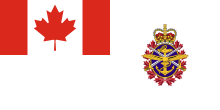|
Personnel branch
 Personnel branches, in the Canadian Armed Forces (CAF), are groupings of related military occupations. Personnel branches were officially established at unification in 1968[1] to amalgamate the old Canadian Army corps and similar occupational groupings in the Royal Canadian Navy and Royal Canadian Air Force. According to Canadian Forces Administrative Orders (CFAOs),
Branches are applicable to all members of the rank of colonel/captain (N) and below; flag and general officers normally do not belong to branches. Exceptions to this rule are the judge advocate general (Legal Branch), the chaplain general (Royal Canadian Chaplain Service), and the surgeon general (Royal Canadian Medical Service). Military occupations for officers and non-commissioned members are grouped within a particular branch under the coordination of the Director – Military Human Resource Requirements (DMHRR) and the approval of the Chief of Military Personnel. UniformsAssignment of distinctive environmental uniform (i.e. "navy", "army", "air force" or "special operations") is a function of military occupation, not personnel branch. For example, within the Communications and Electronics Branch, all signal operators are uniformed army and all aerospace telecommunication and information systems technicians are designated as air force. On the other hand, within the Royal Canadian Logistics Service, supply technicians may be designated as any environment. Branch advisorsEach Branch has its own branch advisor — normally a colonel or naval captain — to the Chief of the Defence Staff. Branch traditionsBranches have carried forward many of the traditions inherited from their corps or service predecessors. They have authorized marches, differences in accessories and accoutrements for full dress and mess dress uniforms, branch-specific toasts, ceremonial commanders such as colonels-in-chief, etc. For example:
List of personnel branchesThe following is a list of CF personnel branches in order of precedence:
References
|